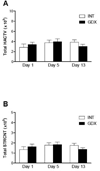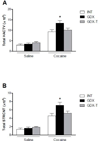Testosterone is essential for cocaine sensitization in male rats
- PMID: 20932851
- PMCID: PMC3703101
- DOI: 10.1016/j.physbeh.2010.09.025
Testosterone is essential for cocaine sensitization in male rats
Abstract
Most studies agree that males and females respond differently to drugs of abuse. In females, estradiol enhances the behavioral response to cocaine. However, studies on the role of testosterone and the locomotor response to psychostimulants in the male rat are inconclusive. Our study was designed to determine the behavioral effects of testosterone on the development and persistence of cocaine sensitization in male rats. We tested different doses of cocaine (10, 15 and 30mg/kg) to determine which dose induced locomotor sensitization in intact (INT) and gonadectomized (GDX) animals. We also investigated if GDX males with testosterone replacement (GDX-T) showed a similar locomotor response to cocaine as INT males. Our data showed that gonadectomy enhanced the locomotor response to a single cocaine injection. This effect was not observed in gonadectomized rats that received testosterone replacement. However, GDX rats did not show a progressive increase in their locomotor response to repeated cocaine administration (15 and 30mg/kg) (sensitization) as did INT and GDX-T animals. It is possible that in GDX males, the initial high locomotor response to cocaine creates a ceiling effect that limits further increase in cocaine-induced hyperactivity. These findings indicate that testosterone not only modulates the behavioral response to a single and to repeated cocaine injections, but is also essential for male rats to become sensitized to cocaine.
2010 Elsevier Inc. All rights reserved.
Figures








Similar articles
-
Endogenous gonadal hormones modulate behavioral and neurochemical responses to acute and chronic cocaine administration.Brain Res. 2002 Jul 26;945(1):123-30. doi: 10.1016/s0006-8993(02)02807-x. Brain Res. 2002. PMID: 12113959
-
Repeated cocaine decreases the avoidance response to a novel aversive stimulus in rats.Psychopharmacology (Berl). 2002 Aug;163(1):9-19. doi: 10.1007/s00213-002-1133-z. Epub 2002 Jun 27. Psychopharmacology (Berl). 2002. PMID: 12185395
-
Acute and repeated intravenous cocaine-induced locomotor activity is altered as a function of sex and gonadectomy.Pharmacol Biochem Behav. 2005 Sep;82(1):170-81. doi: 10.1016/j.pbb.2005.08.005. Epub 2005 Sep 2. Pharmacol Biochem Behav. 2005. PMID: 16139878
-
Cocaine sensitization in male rats requires activation of estrogen receptors.bioRxiv [Preprint]. 2024 Feb 9:2024.02.07.579327. doi: 10.1101/2024.02.07.579327. bioRxiv. 2024. PMID: 38370714 Free PMC article. Preprint.
-
Different locomotor sensitization responses to repeated cocaine injections are associated with differential phosphorylation of GluA1 in the dorsomedial striatum of adult rats.Behav Brain Res. 2013 Nov 15;257:71-6. doi: 10.1016/j.bbr.2013.09.038. Epub 2013 Sep 27. Behav Brain Res. 2013. PMID: 24079996
Cited by
-
Rat Model of Menopausal/Andropausal Hypertension with Different Sensitivities to Non-Genomic Antihypertensive Responses of Female and Male Sex Steroids.Pharmacology. 2025;110(2):98-109. doi: 10.1159/000542007. Epub 2024 Oct 15. Pharmacology. 2025. PMID: 39406205 Free PMC article.
-
Sex differences in the neural mechanisms mediating addiction: a new synthesis and hypothesis.Biol Sex Differ. 2012 Jun 7;3(1):14. doi: 10.1186/2042-6410-3-14. Biol Sex Differ. 2012. PMID: 22676718 Free PMC article.
-
The effects of gonadal hormones on heroin Self-Administration in male gonadectomized rats.Psychopharmacology (Berl). 2024 Jan;241(1):171-179. doi: 10.1007/s00213-023-06471-y. Epub 2023 Oct 13. Psychopharmacology (Berl). 2024. PMID: 37833541 Free PMC article.
-
Cocaine-induced sensitization and glutamate plasticity in the nucleus accumbens core: effects of sex.Biol Sex Differ. 2023 Jun 24;14(1):41. doi: 10.1186/s13293-023-00525-8. Biol Sex Differ. 2023. PMID: 37355656 Free PMC article.
-
Estradiol increases choice of cocaine over food in male rats.Physiol Behav. 2019 May 1;203:18-24. doi: 10.1016/j.physbeh.2017.10.018. Epub 2017 Oct 19. Physiol Behav. 2019. PMID: 29056351 Free PMC article.
References
-
- Van Etten ML, Anthony JC. Comparative epidemiology of initial drug opportunities and transitions to first use: marijuana, cocaine, hallucinogens and heroin. Drug Alcohol Depend. 1999 Apr 1;54(2):117–125. - PubMed
-
- Van Etten ML, Neumark YD, Anthony JC. Male-female differences in the earliest stages of drug involvement. 1999 Sep;94(9):1413–1419. Addiction. - PubMed
-
- McCance-Katz EF, Hart CL, Boyarsky B, Kosten T, Jatlow P. Gender effects following repeated administration of cocaine and alcohol in humans. Subst Use Misuse. 2005;40(4):511–528. - PubMed
-
- Robbins SJ, Ehrman RN, Childress AR, O’Brien CP. Comparing levels of cocaine cue reactivity in male and female outpatients. Drug Alcohol Depend. 1999 Feb 1;53(3):223–230. - PubMed
-
- Lukas SE, Sholar M, Lundahl LH, Lamas X, Kouri E, Wines JD, et al. Sex differences in plasma cocaine levels and subjective effects after acute cocaine administration in human volunteers. Psychopharmacology (Berl) 1996 Jun;125(4):346–354. - PubMed
Publication types
MeSH terms
Substances
Grants and funding
LinkOut - more resources
Full Text Sources

